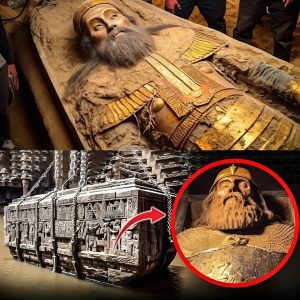In a stunning twist that has captured the attention of historians and scientists alike, the fate of the infamous “Irish Giant” skeleton, which has been a source of controversy for centuries, may soon take an unexpected turn—beneath the waves of the ocean. The remains of Charles Byrne, a man of extraordinary height who lived in the 18th century, have long been the subject of ethical debates, and now, his final resting place could be the deep sea.
The Story of the Irish Giant
Charles Byrne, born in 1761, was an extraordinary figure in his time, standing over seven and a half feet tall. His incredible height, the result of acromegaly, a disorder caused by a tumor on his pituitary gland, made him a sensation across Europe. People flocked to see Byrne, paying for the chance to marvel at his towering presence. But despite his fame, Byrne’s life was fraught with challenges, and his unusual stature brought him as much sorrow as it did attention.
Byrne was acutely aware of how his body could be exploited after his death, and he made clear his wishes to be buried at sea to prevent his remains from being dissected and displayed. Tragically, these wishes were not honored. After his death in 1783, his body was acquired by the renowned surgeon John Hunter, who preserved Byrne’s skeleton and put it on display, where it has remained ever since.
The Ethical Dilemma
For decades, the skeleton of Charles Byrne has been a centerpiece at the Hunterian Museum in London, drawing crowds fascinated by the story of the Irish Giant. However, the display of Byrne’s remains has sparked ongoing ethical debates. Many argue that keeping the skeleton on public view is a violation of Byrne’s explicit wishes and a troubling example of the exploitation of human remains for scientific curiosity.
The controversy has only intensified in recent years, with growing calls for the skeleton to be removed from display and for Byrne’s final wishes to be respected. Scholars, activists, and even some descendants of Byrne’s family have pushed for the skeleton to be buried at sea, as Byrne had originally desired.

A Watery Grave?
Now, the potential resolution to this ethical dilemma could see the Irish Giant’s skeleton laid to rest beneath the ocean waves. Discussions are reportedly underway to honor Byrne’s wishes, with proposals to take the skeleton to a deep-sea location for burial. This move would symbolize a long-overdue respect for Byrne’s final wishes and close a chapter on one of history’s most troubling stories of posthumous exploitation.
If the burial at sea goes ahead, it would be a momentous decision, setting a precedent for how we treat the remains of individuals whose lives were shaped by public curiosity and scientific inquiry. It would also be a profound act of reparation, acknowledging the rights of individuals to decide their own fate, even in death.
The Impact on Science and Society
The potential burial of the Irish Giant’s skeleton also raises questions about the balance between scientific advancement and ethical responsibility. While the skeleton has contributed to significant medical research, particularly in understanding acromegaly and gigantism, it also serves as a reminder of the darker aspects of medical history, where human dignity was often sacrificed in the name of science.
This case could influence future discussions on how we handle human remains in museums and research institutions, emphasizing the importance of consent and respect for the deceased.

Conclusion
As the story of the Irish Giant’s skeleton enters a new chapter, the world watches closely. The decision to bury the remains at sea would be a powerful statement about the importance of honoring an individual’s final wishes, no matter how long ago they were made. For Charles Byrne, the Irish Giant, this could finally mean peace after more than two centuries of public display. Whether beneath the waves or elsewhere, the final resting place of this extraordinary figure could mark a turning point in how we view the intersection of science, ethics, and human dignity.





